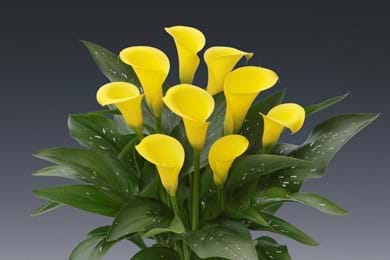
Calla Mini
Production
When you receive the shipment keep the tubers at room temperature and DO NOT put them in a cold cooler. Typically the bulbs will be pretreated with GA and fungicide. It is important to plant bulbs within a few days of arrival. Plant them 1" (2.5cm) deep and evenly in depth.
This will make the crop time more uniform and also the effects of PGR drenches more equal. After watering the tubers, have about 1" (2.5cm) of dirt on top of the tuber. Plant with the sprouts/shoots up and be careful to not damage the tubers in the process. Callas should be planted in moist soil. With multiple tubers per pot make sure that they get planted the same depth and spaced over pot evenly.
Moisture and fertilization
Soil should be a mix that drains well with a high level of peat and perlite added. Callas can grow with little fertilizer. It is recommended to use a basic application of fertilizer prior to planting. High levels of Nitrogen can increase the foliage production but can make the plant soft. This can reduce flower production while Fertilizer requirements Zantedeschias can grow without too much fertilizer. High levels of Nitrogen can increase the foliage production but will make the plant also softer. This can reduce flower production and increase risk of Erwinia and developmental delay. Iron and Boron are two elements that are extremely important in development of Callas. It is suggested to keep EC 1.1-1.3 range as the plant develops. It is always recommended to have soil samples done prior to planting.
Callas prefer to be grown on the dry side. After planting wait 3 to 5 days to water. This is very important! After app. 5 days, give the pots a good watering and irrigation. Callas will make thick white roots and will root throughout the pots. Irrigate early in the morning. Water when the mix is starting to dry out not before that since keeping the medium too moist will cause glassy roots.
Insects and diseases
Once the plant has emerged thru soil it is important to drench with fungicide. A mixture of Clearys and another fungicide often works well. Always be scouting for aphids. They can nestle themselves in between shoots and sometimes can be hard to detect. Marathon has a good long term working solution and can be applied after pair of leaves is visible. Botrytis is also something to be looking for in the fall. It can happen in a few days' time so be aware. It will present itself as small brown spots (circles).
Growth regulation
Bonzi (Paclobutrazol) is most commonly used in Callas to keep them shorter. The rate can vary significantly between varieties. It is also important to consider the time of the year and the age of the tuber when determining rate. Rates start from 5 ppm. For example, a variety that needs PGR in February may need no spray if planted in July. It is suggested to test a rate first for best results. The first 5ppm application (spray or sprench) is given when the sprouts are 1 to 2 inches (2.5-5cm). Then monitor and see if you need do another 5ppm a few weeks later. Please note – a variety that may not require PGR in July may need an application.
Temperature and storing
After planting, keep the greenhouse on the warmer side (62°F to 68°F or 17°C to 20°C) as this will help the tubers emerge. After emerging of the tubers, the greenhouse can be kept at app. 58°F to 60°F (14º-16ºC). Humidity levels should be app. 80%. This can be achieved by a cracked vent and air circulation (fans). During the day keep venting consistent so humidity will be around 60 to 65%.
Flamingo Holland cannot be liable for any loss of profit, growing result, or any other commercial damages resulting from the use of this guide. This guide is for information purposes only and are not warranted for content, accuracy, or performance overall.